



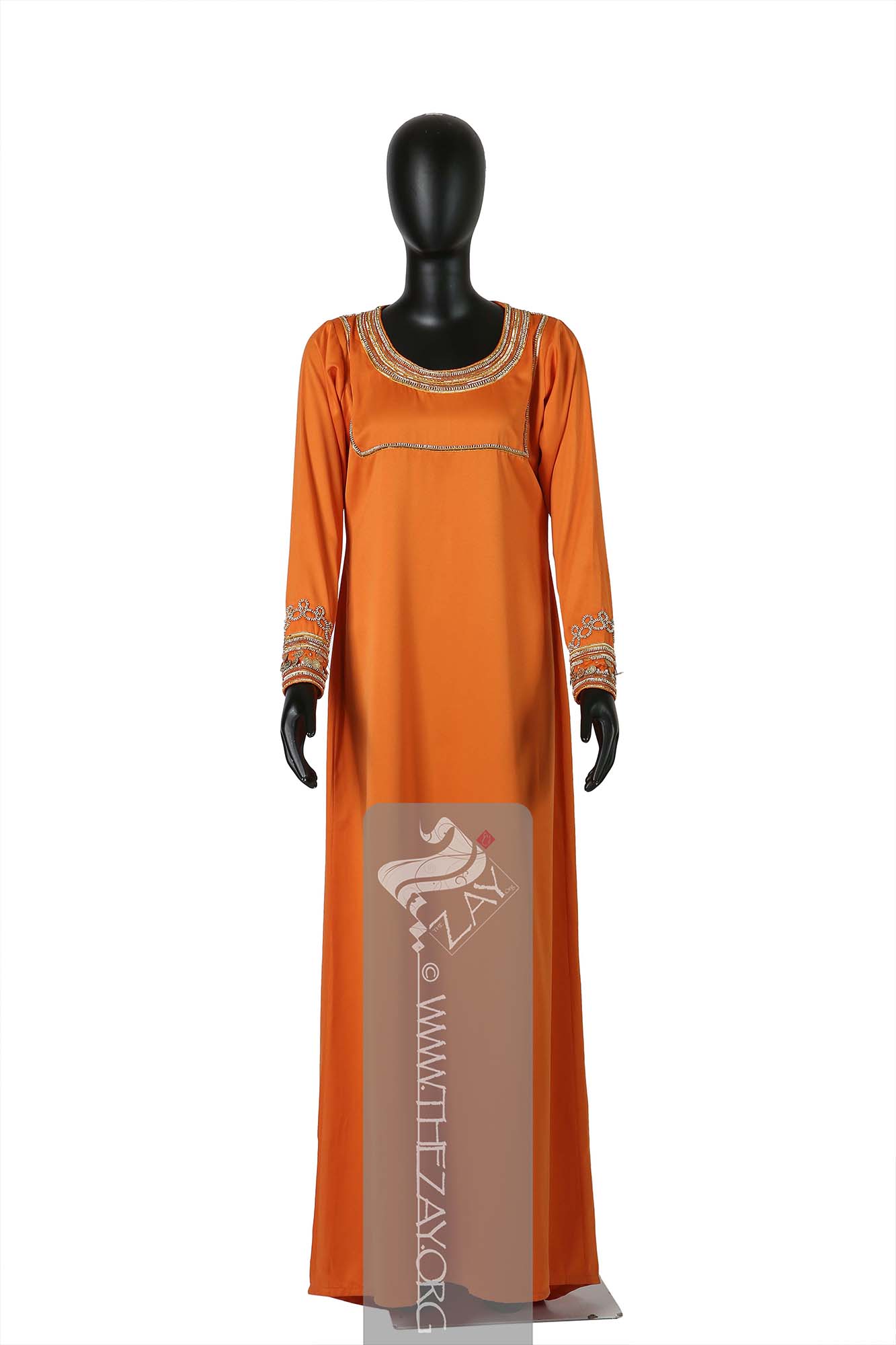

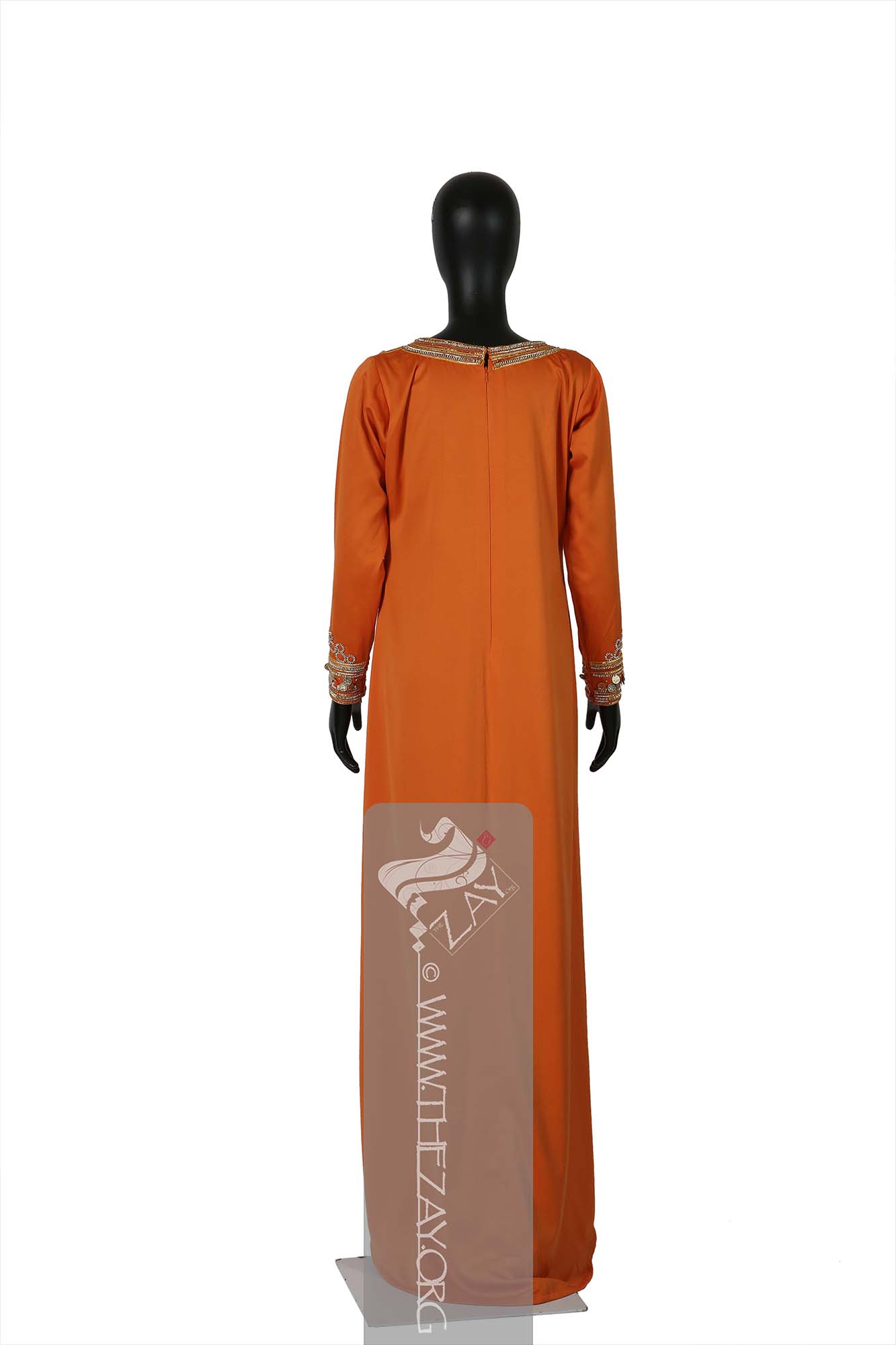
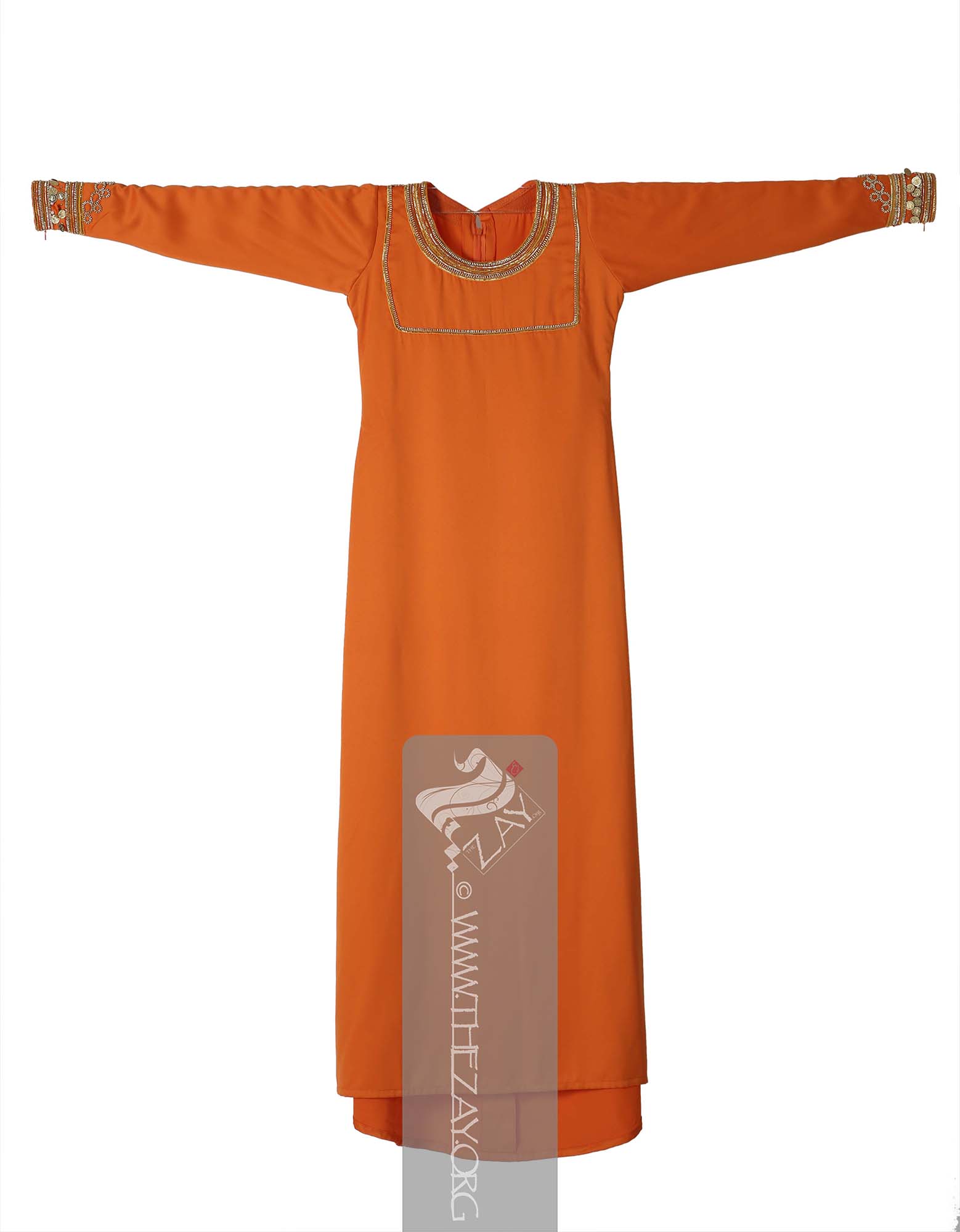
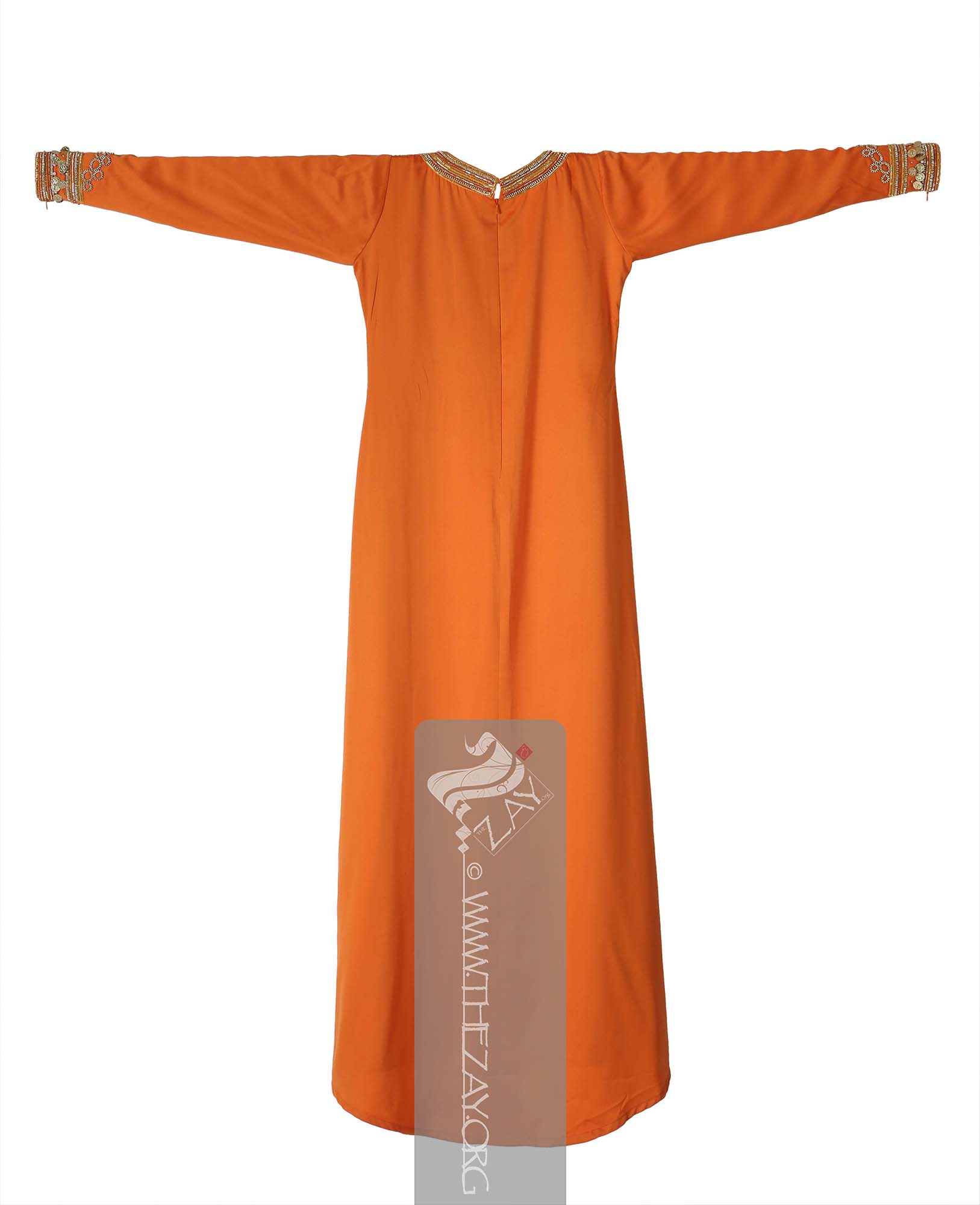
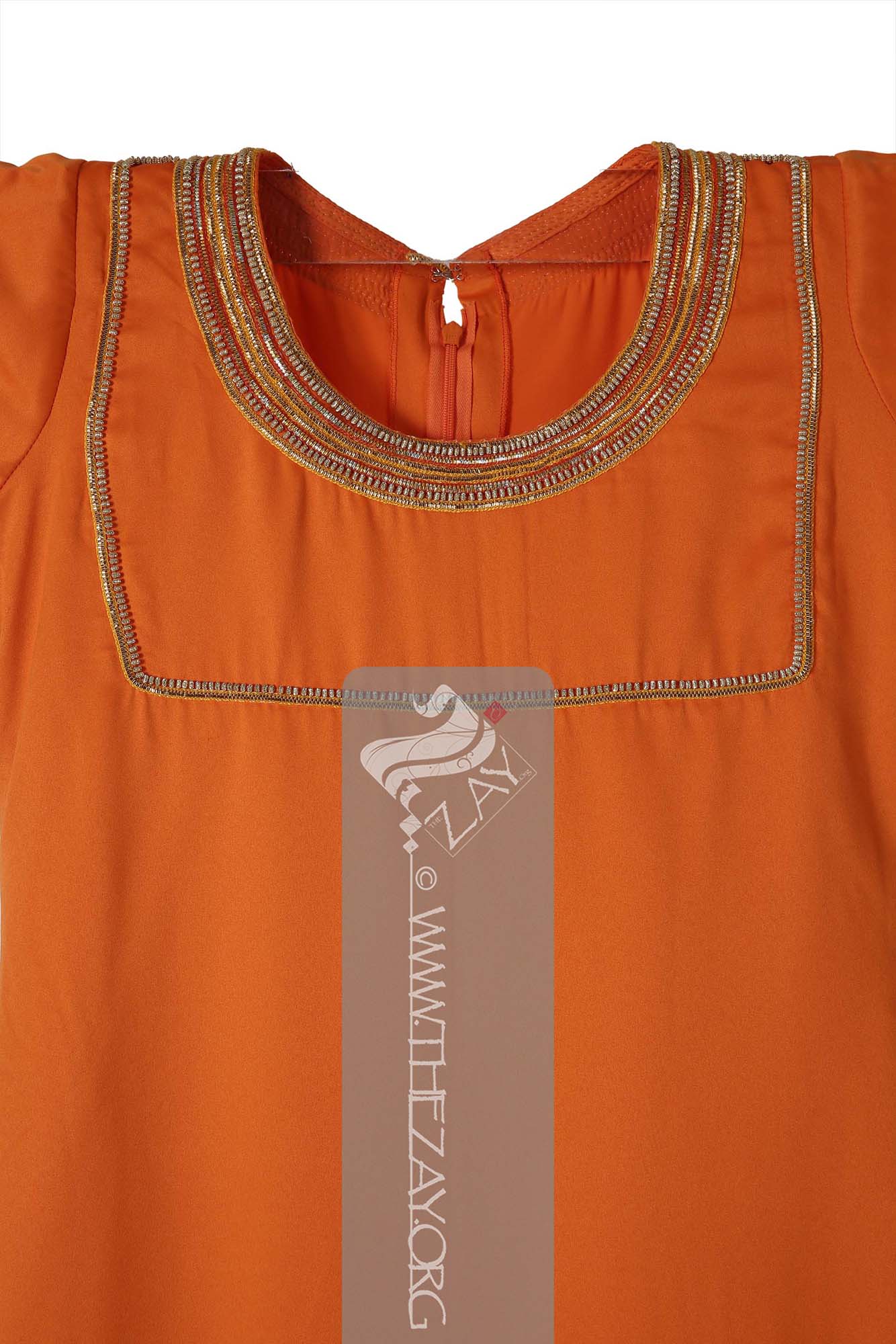
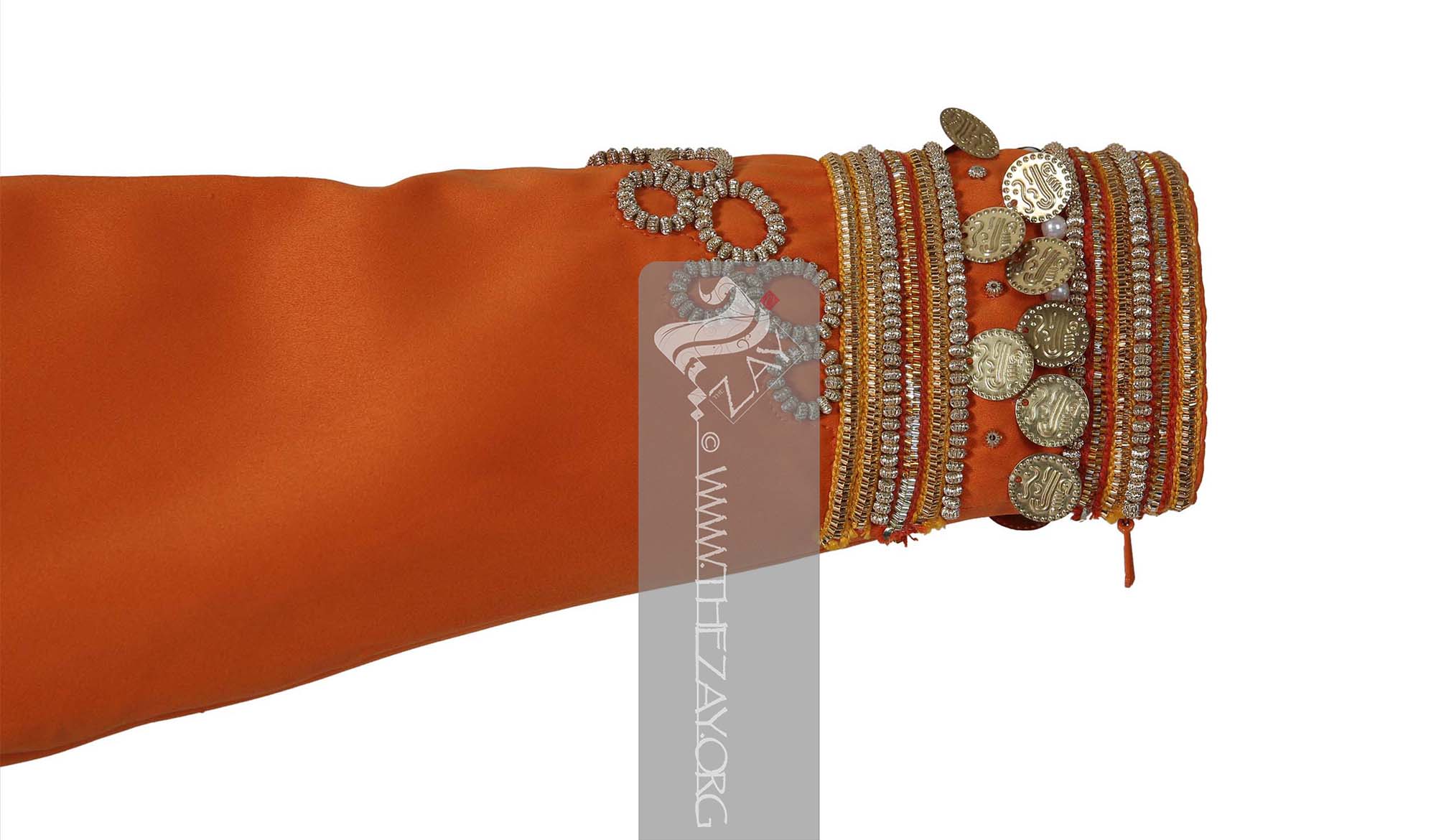

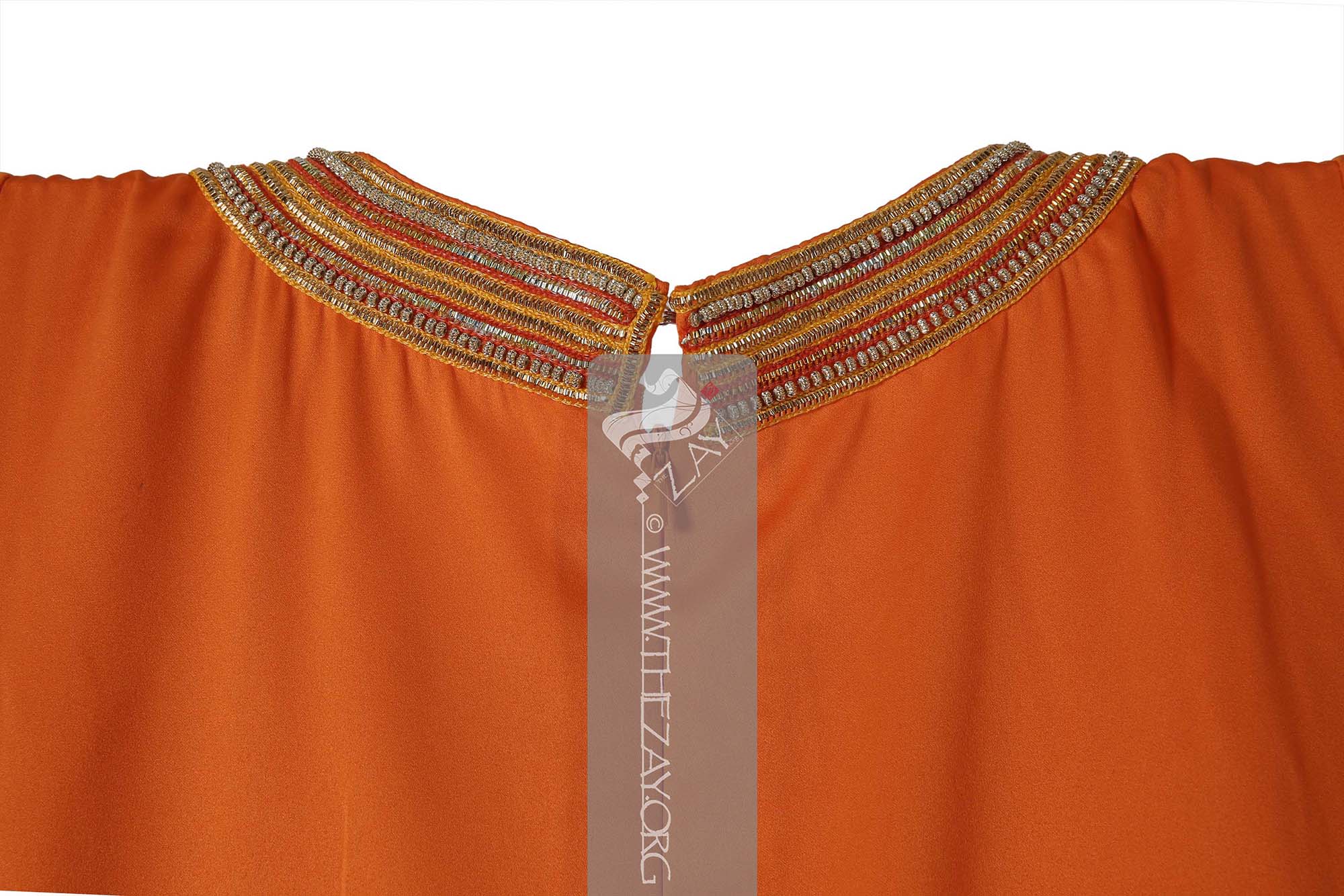
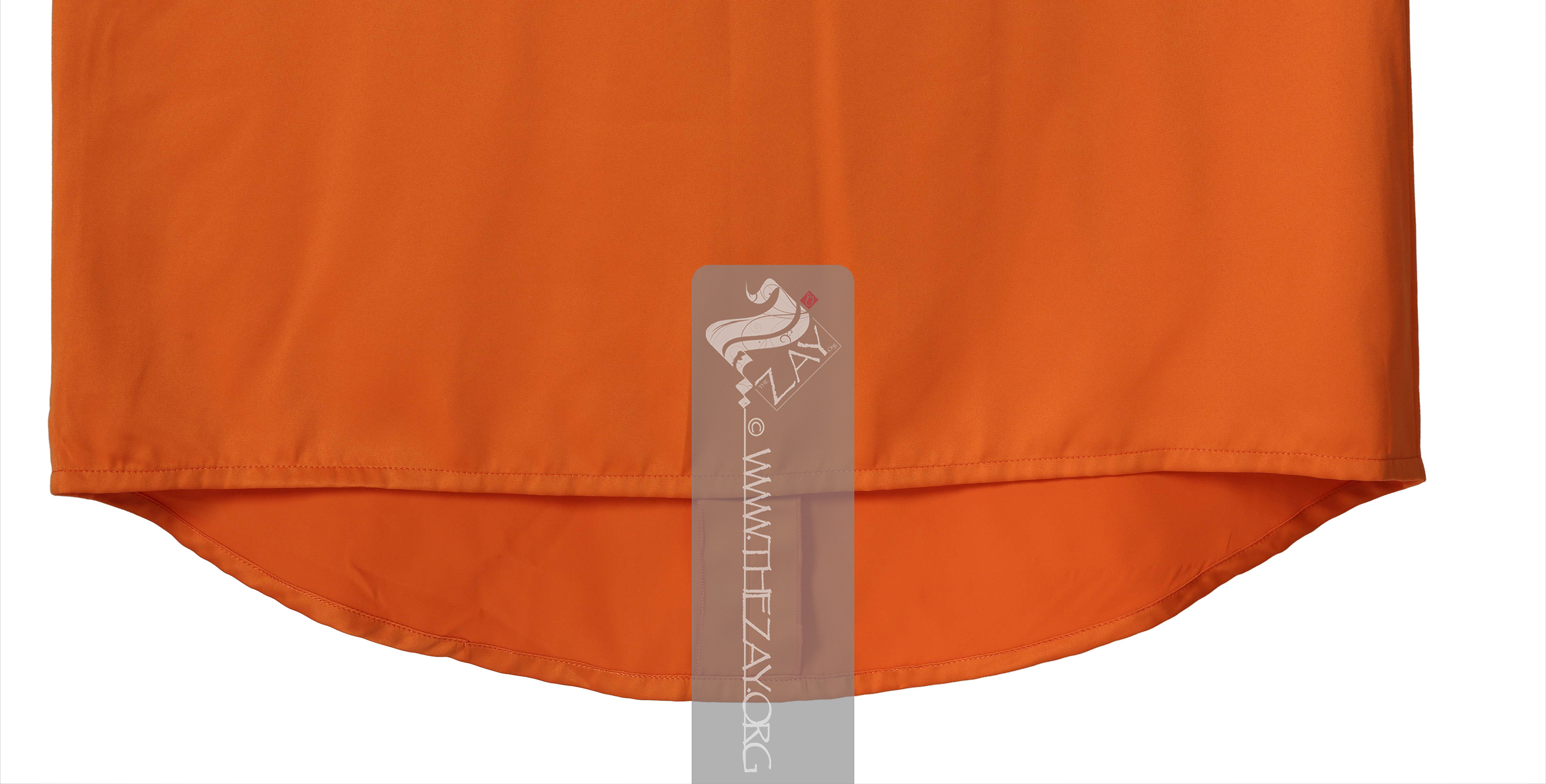
| Local Name | Kandurah |
| Object Category | Tunic dress |
| Gender | Female |
| Date of object | 2021 |
| Place Of orgin | United Arab Emirates |
| Region | Dubai |
| Object Range | United Arab Emirates |
| Dimensions | Length: 156 cm Width: 150 cm |
| Materials | Silk |
| Technique | Machine Stitched Embellished |
| Color | |
| Motif | Geometric |
| Provenance | Donated, Shaikha AL Gaithi, Dubai 2021 |
| Location | Zeman Awwal, Mall of the Emirates, Dubai |
| Status | On Display |
| ZI number | ZI2021.500971.3 UAE |
Qamīṣ: (Possibly late Latin: Camisia – Linen Undergarment; Synonym: Kamiz), a traditional loose fitting long tunic or shirt worn by both men and women in South and Central Asia and the Arab world. Typically extending below the waist it is usually paired with a pair of trousers.
) tunic with frontal neckline opening. Each Arab region has a different term for what is essentially a similar garment with various small differences. , mqta’, thawb Thawb: (Arabic: thawb, Pl. Athwāb/thībān), can be pronounced thobe Thobe: (Arabic: thawb, Pl. Athwāb/thībān), can be pronounced thawb or tobe Tobe: (Arabic: thawb, Pl. Athwāb/thībān), can be pronounced thawb or thobe based on locale. The standard Arabic word for ‘fabric’ or ‘garment’. It can refer to a qamīs-like tunic worn by men and women in the Arabian Peninsula, Iraq, the southern and south-western ports and islands of Iran, and some countries in East and West Africa. More specifically, it can refer to the square-shaped Bedouin overgarment worn by women. based on locale. The standard Arabic word for ‘fabric’ or ‘garment’. It can also refer to a qamīs-like tunic worn by men and women in the Arabian Peninsula, Iraq, the southern and south-western ports and islands of Iran, and some countries in East and West Africa. More specifically, it can refer to the square-shaped Bedouin overgarment worn by women. or tobe Tobe: (Arabic: thawb, Pl. Athwāb/thībān), can be pronounced thawb or thobe based on locale. The standard Arabic word for ‘fabric’ or ‘garment’. It can refer to a qamīs-like tunic worn by men and women in the Arabian Peninsula, Iraq, the southern and south-western ports and islands of Iran, and some countries in East and West Africa. More specifically, it can refer to the square-shaped Bedouin overgarment worn by women. based on locale. The standard Arabic word for ‘fabric’ or ‘garment’. It can also refer to a qamīs-like tunic worn by men and women in the Arabian Peninsula, Iraq, the southern and south-western ports and islands of Iran, and some countries in East and West Africa. More specifically, it can refer to the square-shaped Bedouin overgarment worn by women in the Arabian Gulf region. or tobe Tobe: (Arabic: thawb, Pl. Athwāb/thībān), can be pronounced thawb or thobe based on locale. The standard Arabic word for ‘fabric’ or ‘garment’. It can refer to a qamīs-like tunic worn by men and women in the Arabian Peninsula, Iraq, the southern and south-western ports and islands of Iran, and some countries in East and West Africa. More specifically, it can refer to the square-shaped Bedouin overgarment worn by women. ) loose, short or long sleeved, shirt like (qamisQamīṣ: (Possibly late Latin: Camisia – Linen Undergarment; Synonym: Kamiz), a traditional loose fitting long tunic or shirt worn by both men and women in South and Central Asia and the Arab world. Typically extending below the waist it is usually paired with a pair of trousers.
) tunic with frontal neckline opening, worn by both sexes. Each Arab region has a different term for what is essentially a similar garment with various small differences.) is part of an ensemble together with overgarment (thawb Thawb: (Arabic: thawb, Pl. Athwāb/thībān), can be pronounced thobe Thobe: (Arabic: thawb, Pl. Athwāb/thībān), can be pronounced thawb or tobe Tobe: (Arabic: thawb, Pl. Athwāb/thībān), can be pronounced thawb or thobe based on locale. The standard Arabic word for ‘fabric’ or ‘garment’. It can refer to a qamīs-like tunic worn by men and women in the Arabian Peninsula, Iraq, the southern and south-western ports and islands of Iran, and some countries in East and West Africa. More specifically, it can refer to the square-shaped Bedouin overgarment worn by women. based on locale. The standard Arabic word for ‘fabric’ or ‘garment’. It can also refer to a qamīs-like tunic worn by men and women in the Arabian Peninsula, Iraq, the southern and south-western ports and islands of Iran, and some countries in East and West Africa. More specifically, it can refer to the square-shaped Bedouin overgarment worn by women. or tobe Tobe: (Arabic: thawb, Pl. Athwāb/thībān), can be pronounced thawb or thobe based on locale. The standard Arabic word for ‘fabric’ or ‘garment’. It can refer to a qamīs-like tunic worn by men and women in the Arabian Peninsula, Iraq, the southern and south-western ports and islands of Iran, and some countries in East and West Africa. More specifically, it can refer to the square-shaped Bedouin overgarment worn by women. based on locale. The standard Arabic word for ‘fabric’ or ‘garment’. It can also refer to a qamīs-like tunic worn by men and women in the Arabian Peninsula, Iraq, the southern and south-western ports and islands of Iran, and some countries in East and West Africa. More specifically, it can refer to the square-shaped Bedouin overgarment worn by women in the Arabian Gulf region. ) (ZI2021.500971.3a UAE), veil (shaylah Shaylah: (Colloquial Gulf Arabic), a length of fabric used as shawl, head cover or veil. Also known as (wigāyah) or (milfa’), generally made from sheer fabrics such as tulle (tūr), cotton gauze (wasmah Wasmah: (Arabic: woad), is derived from the woad herb (wasmah) used to dye the cotton gauze black. It is mainly used for headcovers or veils and overgarments in most of the Arab gulf region.) (nidwah) or (Nīl), or silk chiffon (sarī).) (ZI2021.500971.3b UAE), and a group of imitation jewellery in traditional UAE style: necklace (mriyah_um_shnaf Mrīyah_um_shnāf: (known, synonym:sitmī, mrīyah um ‘Um: (Arabic: mother), a sign of respect or formality, women are not addressed by their own names, rather as mother of, then adding the name of the eldest son as in Um Mohammed. Also can mean: with, for example (‘um mishakhiṣ) meaning with gold embellishment. hlal), long gold bead strand necklace in different shapes and sizes strung on red cotton thread and end with a dangling medallion (shnaf Shnāf: (unknown, synonym: tfruqah Tfrūqah: (unknown, synonyms: shnaf, tabā’ah, hyar, hlali), generally triangular or crescent shape medallion worn dangling on the forehead or as part of a longer necklace (mriyah_um_shnaf), common to the UAE, Oman, Qatar, and other Arab gulf states., tabā’ah, hyar, hlali) generally triangular or crescent shape medallion worn dangling on the forehead or as part of a longer necklace (mriyah_um_shnaf), common to the UAE, Oman, Qatar, and other Arab gulf states. / tfruqah Tfrūqah: (unknown, synonyms: shnaf, tabā’ah, hyar, hlali), generally triangular or crescent shape medallion worn dangling on the forehead or as part of a longer necklace (mriyah_um_shnaf), common to the UAE, Oman, Qatar, and other Arab gulf states.), common to the UAE, Oman, Qatar, and other Arab gulf states.) (ZI2021.500971.3c UAE), hair accessory (hyar Hyār: (unkown, synonym:naql Naql: (unknown, synonyms: hyar, majlah), decorative golden chain that comes different motifs, similar to a headband worn across connecting ear to ear and ending with small rings where earrings are dangled. At times it has a medallion (shnaf Shnāf: (unknown, synonym: tfruqah Tfrūqah: (unknown, synonyms: shnaf, tabā’ah, hyar, hlali), generally triangular or crescent shape medallion worn dangling on the forehead or as part of a longer necklace (mriyah_um_shnaf), common to the UAE, Oman, Qatar, and other Arab gulf states., tabā’ah, hyar, hlali) generally triangular or crescent shape medallion worn dangling on the forehead or as part of a longer necklace (mriyah_um_shnaf), common to the UAE, Oman, Qatar, and other Arab gulf states./taba’ah Tabā’ah: (Arabic: to follow, synonyms: shnaf, tfruqah Tfrūqah: (unknown, synonyms: shnaf, tabā’ah, hyar, hlali), generally triangular or crescent shape medallion worn dangling on the forehead or as part of a longer necklace (mriyah_um_shnaf), common to the UAE, Oman, Qatar, and other Arab gulf states., hyar, hlali), generally triangular or crescent shape medallion worn dangling on the forehead or as part of a longer necklace (mriyah_um_shnaf), common to the UAE, Oman, Qatar and other Arab gulf states./tfruqah Tfrūqah: (unknown, synonyms: shnaf, tabā’ah, hyar, hlali), generally triangular or crescent shape medallion worn dangling on the forehead or as part of a longer necklace (mriyah_um_shnaf), common to the UAE, Oman, Qatar, and other Arab gulf states.) attached on the forehead or additional dangling chain layers covering the crown of the head. Common to the UAE, Oman, Qatar and other Arab gulf states., majlah Majlah: (unknown, synonyms: hyar, naql Naql: (unknown, synonyms: hyar, majlah), decorative golden chain that comes different motifs, similar to a headband worn across connecting ear to ear and ending with small rings where earrings are dangled. At times it has a medallion (shnaf Shnāf: (unknown, synonym: tfruqah Tfrūqah: (unknown, synonyms: shnaf, tabā’ah, hyar, hlali), generally triangular or crescent shape medallion worn dangling on the forehead or as part of a longer necklace (mriyah_um_shnaf), common to the UAE, Oman, Qatar, and other Arab gulf states., tabā’ah, hyar, hlali) generally triangular or crescent shape medallion worn dangling on the forehead or as part of a longer necklace (mriyah_um_shnaf), common to the UAE, Oman, Qatar, and other Arab gulf states./taba’ah Tabā’ah: (Arabic: to follow, synonyms: shnaf, tfruqah Tfrūqah: (unknown, synonyms: shnaf, tabā’ah, hyar, hlali), generally triangular or crescent shape medallion worn dangling on the forehead or as part of a longer necklace (mriyah_um_shnaf), common to the UAE, Oman, Qatar, and other Arab gulf states., hyar, hlali), generally triangular or crescent shape medallion worn dangling on the forehead or as part of a longer necklace (mriyah_um_shnaf), common to the UAE, Oman, Qatar and other Arab gulf states./tfruqah Tfrūqah: (unknown, synonyms: shnaf, tabā’ah, hyar, hlali), generally triangular or crescent shape medallion worn dangling on the forehead or as part of a longer necklace (mriyah_um_shnaf), common to the UAE, Oman, Qatar, and other Arab gulf states.) attached on the forehead or additional dangling chain layers covering the crown of the head. Common to the UAE, Oman, Qatar and other Arab gulf states.), decorative golden chain that comes different motifs, similar to a headband worn across connecting ear to ear and ending with small rings where earrings are dangled. At times it has a medallion (shnaf Shnāf: (unknown, synonym: tfruqah Tfrūqah: (unknown, synonyms: shnaf, tabā’ah, hyar, hlali), generally triangular or crescent shape medallion worn dangling on the forehead or as part of a longer necklace (mriyah_um_shnaf), common to the UAE, Oman, Qatar, and other Arab gulf states., tabā’ah, hyar, hlali) generally triangular or crescent shape medallion worn dangling on the forehead or as part of a longer necklace (mriyah_um_shnaf), common to the UAE, Oman, Qatar, and other Arab gulf states./taba’ah Tabā’ah: (Arabic: to follow, synonyms: shnaf, tfruqah Tfrūqah: (unknown, synonyms: shnaf, tabā’ah, hyar, hlali), generally triangular or crescent shape medallion worn dangling on the forehead or as part of a longer necklace (mriyah_um_shnaf), common to the UAE, Oman, Qatar, and other Arab gulf states., hyar, hlali), generally triangular or crescent shape medallion worn dangling on the forehead or as part of a longer necklace (mriyah_um_shnaf), common to the UAE, Oman, Qatar and other Arab gulf states./tfruqah Tfrūqah: (unknown, synonyms: shnaf, tabā’ah, hyar, hlali), generally triangular or crescent shape medallion worn dangling on the forehead or as part of a longer necklace (mriyah_um_shnaf), common to the UAE, Oman, Qatar, and other Arab gulf states.) attached on the forehead or additional dangling chain layers covering the crown of the head. Common to the UAE, Oman, Qatar, and other Arab gulf states.), decorative golden chain that comes in different motifs, similar to a headband worn across connecting ear to ear and ending with small rings for earrings to dangle. At times it has a medallion (shnaf Shnāf: (unknown, synonym: tfruqah Tfrūqah: (unknown, synonyms: shnaf, tabā’ah, hyar, hlali), generally triangular or crescent shape medallion worn dangling on the forehead or as part of a longer necklace (mriyah_um_shnaf), common to the UAE, Oman, Qatar, and other Arab gulf states., tabā’ah, hyar, hlali) generally triangular or crescent shape medallion worn dangling on the forehead or as part of a longer necklace (mriyah_um_shnaf), common to the UAE, Oman, Qatar, and other Arab gulf states./taba’ah Tabā’ah: (Arabic: to follow, synonyms: shnaf, tfruqah Tfrūqah: (unknown, synonyms: shnaf, tabā’ah, hyar, hlali), generally triangular or crescent shape medallion worn dangling on the forehead or as part of a longer necklace (mriyah_um_shnaf), common to the UAE, Oman, Qatar, and other Arab gulf states., hyar, hlali), generally triangular or crescent shape medallion worn dangling on the forehead or as part of a longer necklace (mriyah_um_shnaf), common to the UAE, Oman, Qatar and other Arab gulf states./tfruqah Tfrūqah: (unknown, synonyms: shnaf, tabā’ah, hyar, hlali), generally triangular or crescent shape medallion worn dangling on the forehead or as part of a longer necklace (mriyah_um_shnaf), common to the UAE, Oman, Qatar, and other Arab gulf states.) attached on the forehead or additional dangling chain layers covering the crown of the head. Common to the UAE, Oman, Qatar, and other Arab gulf states.) (ZI2021.500971.3d UAE), & earrings (kwashi Kwāshī (Persian: cage, synonym: tarachi Tarāchī: (Arabised from Turkey), meaning earrings, common to the UAE, Oman, Qatar and other Arab gulf states.), meaning earrings, common to the UAE, Oman, Qatar, and other Arab gulf states.) (ZI2021.500971.3e UAE).Qamīṣ: (Possibly late Latin: Camisia – Linen Undergarment; Synonym: Kamiz), a traditional loose fitting long tunic or shirt worn by both men and women in South and Central Asia and the Arab world. Typically extending below the waist it is usually paired with a pair of trousers.
) tunic with frontal neckline opening. Each Arab region has a different term for what is essentially a similar garment with various small differences. , mqta’, thawb Thawb: (Arabic: thawb, Pl. Athwāb/thībān), can be pronounced thobe Thobe: (Arabic: thawb, Pl. Athwāb/thībān), can be pronounced thawb or tobe Tobe: (Arabic: thawb, Pl. Athwāb/thībān), can be pronounced thawb or thobe based on locale. The standard Arabic word for ‘fabric’ or ‘garment’. It can refer to a qamīs-like tunic worn by men and women in the Arabian Peninsula, Iraq, the southern and south-western ports and islands of Iran, and some countries in East and West Africa. More specifically, it can refer to the square-shaped Bedouin overgarment worn by women. based on locale. The standard Arabic word for ‘fabric’ or ‘garment’. It can also refer to a qamīs-like tunic worn by men and women in the Arabian Peninsula, Iraq, the southern and south-western ports and islands of Iran, and some countries in East and West Africa. More specifically, it can refer to the square-shaped Bedouin overgarment worn by women. or tobe Tobe: (Arabic: thawb, Pl. Athwāb/thībān), can be pronounced thawb or thobe based on locale. The standard Arabic word for ‘fabric’ or ‘garment’. It can refer to a qamīs-like tunic worn by men and women in the Arabian Peninsula, Iraq, the southern and south-western ports and islands of Iran, and some countries in East and West Africa. More specifically, it can refer to the square-shaped Bedouin overgarment worn by women. based on locale. The standard Arabic word for ‘fabric’ or ‘garment’. It can also refer to a qamīs-like tunic worn by men and women in the Arabian Peninsula, Iraq, the southern and south-western ports and islands of Iran, and some countries in East and West Africa. More specifically, it can refer to the square-shaped Bedouin overgarment worn by women in the Arabian Gulf region. or tobe Tobe: (Arabic: thawb, Pl. Athwāb/thībān), can be pronounced thawb or thobe based on locale. The standard Arabic word for ‘fabric’ or ‘garment’. It can refer to a qamīs-like tunic worn by men and women in the Arabian Peninsula, Iraq, the southern and south-western ports and islands of Iran, and some countries in East and West Africa. More specifically, it can refer to the square-shaped Bedouin overgarment worn by women. ) loose, short or long sleeved, shirt like (qamisQamīṣ: (Possibly late Latin: Camisia – Linen Undergarment; Synonym: Kamiz), a traditional loose fitting long tunic or shirt worn by both men and women in South and Central Asia and the Arab world. Typically extending below the waist it is usually paired with a pair of trousers.
) tunic with frontal neckline opening, worn by both sexes. Each Arab region has a different term for what is essentially a similar garment with various small differences.) underneath. Soon this evolved into matching sets known as (thawb_wa_kandurah Thawb_wa_kandūrah: (colloquial, UAE), an elaborate form of the traditional overgarment (thawb) and tunic (kandūrah) ensemble, that evolved post-1980s where the two garments became matched as a set.), where the two garments were made of the same or coordinating fabrics and colours. By the late 1990s, this evolved further, as the two separate articles were merged into one and became attached at the neckline, using the inner tunic as lining and creating a combination overgarment tunic (thawb_kandurah Thawb_kandūrah: (colloquial, UAE), post-1990s the (Thawb_wa_kandūrah) ensemble of the eighties evolved where the overgarment (thawb) and tunic (kandūrah) became united at the neckline creating one outfit and inner tunic receding to act as lining.).Salwar: (Farsi: shalvār; Synonym: ṣarwāl, shirwāl ), trousers featuring tapering ankles and drawstring closure of Central Asian origin. They disseminated in the Indian subcontinent between c.1st-3rd century BCE. Although exact period of its arrival in the Arab world is disputed their widespread adoption is confirmed from the 12th century.
, churidars, or pyjama. In Hijazi dialect, the term refers to a sleeved, waist-cinched dress that comes in different styles, popularly worn since the 1950s., kirtah Kirtah: (Punjabi: kurta Kūrtā: (Urdu and Persian: kurtah Kurtah: (Urdu and Persian: kurta, synonyms: bīchī, gawan, fustān, nafnūf, kirtah), a loose sleeveless shirt of varying lengths, typically falling either just above or somewhere below the knees, with its side-seams left open at the bottom, worn in South Asia, usually with a salwarSalwar: (Farsi: shalvār; Synonym: ṣarwāl, shirwāl ), trousers featuring tapering ankles and drawstring closure of Central Asian origin. They disseminated in the Indian subcontinent between c.1st-3rd century BCE. Although exact period of its arrival in the Arab world is disputed their widespread adoption is confirmed from the 12th century.
, churidars, or pyjama. In Hijazi dialect, the term refers to a sleeved, waist-cinched dress that comes in different styles, popularly worn since the 1950s.). a sleeveless shirt of varying length, typically falling either just above or somewhere below the knees of the wearer, with its side-seams left open at the bottom., synonyms: bīchī, gawan, fustān, nafnūf), colloquially in KSA, Kuwait and Bahrain refers to sleeved, waist-cinched dress that comes in different styles.), colloquial term used in UAE for a sleeved, waist-cinched full-length dress of varying lengths and styles.) or (nafnuf Nafnūf: (Arabic: nafnaf: airy, pl. nafānīf, synonyms: bīchī, gawan, fustān, kurtah, kirtah), referring to sleeved, waist-cinched dress of varying lengths and styles. ) or (biji Bījī: (Unknown, synonyms: fustān, gawan Gawan: (English: gown, or Arabic: qawan, synonyms: bīchī, fustān, nafnūf, kurtah Kurtah: (Urdu and Persian: kurta, synonyms: bīchī, gawan, fustān, nafnūf, kirtah), a loose sleeveless shirt of varying lengths, typically falling either just above or somewhere below the knees, with its side-seams left open at the bottom, worn in South Asia, usually with a salwarSalwar: (Farsi: shalvār; Synonym: ṣarwāl, shirwāl ), trousers featuring tapering ankles and drawstring closure of Central Asian origin. They disseminated in the Indian subcontinent between c.1st-3rd century BCE. Although exact period of its arrival in the Arab world is disputed their widespread adoption is confirmed from the 12th century.
, churidars, or pyjama. In Hijazi dialect, the term refers to a sleeved, waist-cinched dress that comes in different styles, popularly worn since the 1950s., kirtah Kirtah: (Punjabi: kurta Kūrtā: (Urdu and Persian: kurtah Kurtah: (Urdu and Persian: kurta, synonyms: bīchī, gawan, fustān, nafnūf, kirtah), a loose sleeveless shirt of varying lengths, typically falling either just above or somewhere below the knees, with its side-seams left open at the bottom, worn in South Asia, usually with a salwarSalwar: (Farsi: shalvār; Synonym: ṣarwāl, shirwāl ), trousers featuring tapering ankles and drawstring closure of Central Asian origin. They disseminated in the Indian subcontinent between c.1st-3rd century BCE. Although exact period of its arrival in the Arab world is disputed their widespread adoption is confirmed from the 12th century.
, churidars, or pyjama. In Hijazi dialect, the term refers to a sleeved, waist-cinched dress that comes in different styles, popularly worn since the 1950s.). a sleeveless shirt of varying length, typically falling either just above or somewhere below the knees of the wearer, with its side-seams left open at the bottom., synonyms: bīchī, gawan, fustān, nafnūf), colloquially in KSA, Kuwait and Bahrain refers to sleeved, waist-cinched dress that comes in different styles.), colloquial term used in UAE for a sleeved, waist-cinched full-length dress of varying lengths and styles., nafnūf, kurtah Kurtah: (Urdu and Persian: kurta, synonyms: bīchī, gawan, fustān, nafnūf, kirtah), a loose sleeveless shirt of varying lengths, typically falling either just above or somewhere below the knees, with its side-seams left open at the bottom, worn in South Asia, usually with a salwarSalwar: (Farsi: shalvār; Synonym: ṣarwāl, shirwāl ), trousers featuring tapering ankles and drawstring closure of Central Asian origin. They disseminated in the Indian subcontinent between c.1st-3rd century BCE. Although exact period of its arrival in the Arab world is disputed their widespread adoption is confirmed from the 12th century.
, churidars, or pyjama. In Hijazi dialect, the term refers to a sleeved, waist-cinched dress that comes in different styles, popularly worn since the 1950s.), also pronounced bīchī, in the UAE the term colloquially refers to full-length waist cinched dress. / bichi Bīchī: (Unknown, synonyms: fustān, gawan Gawan: (English: gown, or Arabic: qawan, synonyms: bīchī, fustān, nafnūf, kurtah Kurtah: (Urdu and Persian: kurta, synonyms: bīchī, gawan, fustān, nafnūf, kirtah), a loose sleeveless shirt of varying lengths, typically falling either just above or somewhere below the knees, with its side-seams left open at the bottom, worn in South Asia, usually with a salwarSalwar: (Farsi: shalvār; Synonym: ṣarwāl, shirwāl ), trousers featuring tapering ankles and drawstring closure of Central Asian origin. They disseminated in the Indian subcontinent between c.1st-3rd century BCE. Although exact period of its arrival in the Arab world is disputed their widespread adoption is confirmed from the 12th century.
, churidars, or pyjama. In Hijazi dialect, the term refers to a sleeved, waist-cinched dress that comes in different styles, popularly worn since the 1950s., kirtah Kirtah: (Punjabi: kurta Kūrtā: (Urdu and Persian: kurtah Kurtah: (Urdu and Persian: kurta, synonyms: bīchī, gawan, fustān, nafnūf, kirtah), a loose sleeveless shirt of varying lengths, typically falling either just above or somewhere below the knees, with its side-seams left open at the bottom, worn in South Asia, usually with a salwarSalwar: (Farsi: shalvār; Synonym: ṣarwāl, shirwāl ), trousers featuring tapering ankles and drawstring closure of Central Asian origin. They disseminated in the Indian subcontinent between c.1st-3rd century BCE. Although exact period of its arrival in the Arab world is disputed their widespread adoption is confirmed from the 12th century.
, churidars, or pyjama. In Hijazi dialect, the term refers to a sleeved, waist-cinched dress that comes in different styles, popularly worn since the 1950s.). a sleeveless shirt of varying length, typically falling either just above or somewhere below the knees of the wearer, with its side-seams left open at the bottom., synonyms: bīchī, gawan, fustān, nafnūf), colloquially in KSA, Kuwait and Bahrain refers to sleeved, waist-cinched dress that comes in different styles.), colloquial term used in UAE for a sleeved, waist-cinched full-length dress of varying lengths and styles., nafnūf, kurtah Kurtah: (Urdu and Persian: kurta, synonyms: bīchī, gawan, fustān, nafnūf, kirtah), a loose sleeveless shirt of varying lengths, typically falling either just above or somewhere below the knees, with its side-seams left open at the bottom, worn in South Asia, usually with a salwarSalwar: (Farsi: shalvār; Synonym: ṣarwāl, shirwāl ), trousers featuring tapering ankles and drawstring closure of Central Asian origin. They disseminated in the Indian subcontinent between c.1st-3rd century BCE. Although exact period of its arrival in the Arab world is disputed their widespread adoption is confirmed from the 12th century.
, churidars, or pyjama. In Hijazi dialect, the term refers to a sleeved, waist-cinched dress that comes in different styles, popularly worn since the 1950s., kirtah Kirtah: (Punjabi: kurta Kūrtā: (Urdu and Persian: kurtah Kurtah: (Urdu and Persian: kurta, synonyms: bīchī, gawan, fustān, nafnūf, kirtah), a loose sleeveless shirt of varying lengths, typically falling either just above or somewhere below the knees, with its side-seams left open at the bottom, worn in South Asia, usually with a salwarSalwar: (Farsi: shalvār; Synonym: ṣarwāl, shirwāl ), trousers featuring tapering ankles and drawstring closure of Central Asian origin. They disseminated in the Indian subcontinent between c.1st-3rd century BCE. Although exact period of its arrival in the Arab world is disputed their widespread adoption is confirmed from the 12th century.
, churidars, or pyjama. In Hijazi dialect, the term refers to a sleeved, waist-cinched dress that comes in different styles, popularly worn since the 1950s.). a sleeveless shirt of varying length, typically falling either just above or somewhere below the knees of the wearer, with its side-seams left open at the bottom., synonyms: bīchī, gawan, fustān, nafnūf), colloquially in KSA, Kuwait and Bahrain refers to sleeved, waist-cinched dress that comes in different styles.), also pronounced bījī, in the UAE the term colloquially refers to a sleeved, full-length waist–cinched dress of varying lengths and styles.) rather than the traditional tunic (kandurah Kandūrah: (Arabic: qandūrah, pl. kanādīr, synonyms: ghandurah, qandurah Qandūrah: (Arabic, pl. qanādīr, synonyms: ghandurah, darā’ah, dishdāshah, jalābah, jallābīyah, qaftan, mqta’, thawb Thawb: (Arabic: thawb, Pl. Athwāb/thībān), can be pronounced thobe Thobe: (Arabic: thawb, Pl. Athwāb/thībān), can be pronounced thawb or tobe Tobe: (Arabic: thawb, Pl. Athwāb/thībān), can be pronounced thawb or thobe based on locale. The standard Arabic word for ‘fabric’ or ‘garment’. It can refer to a qamīs-like tunic worn by men and women in the Arabian Peninsula, Iraq, the southern and south-western ports and islands of Iran, and some countries in East and West Africa. More specifically, it can refer to the square-shaped Bedouin overgarment worn by women. based on locale. The standard Arabic word for ‘fabric’ or ‘garment’. It can also refer to a qamīs-like tunic worn by men and women in the Arabian Peninsula, Iraq, the southern and south-western ports and islands of Iran, and some countries in East and West Africa. More specifically, it can refer to the square-shaped Bedouin overgarment worn by women. or tobe Tobe: (Arabic: thawb, Pl. Athwāb/thībān), can be pronounced thawb or thobe based on locale. The standard Arabic word for ‘fabric’ or ‘garment’. It can refer to a qamīs-like tunic worn by men and women in the Arabian Peninsula, Iraq, the southern and south-western ports and islands of Iran, and some countries in East and West Africa. More specifically, it can refer to the square-shaped Bedouin overgarment worn by women. based on locale. The standard Arabic word for ‘fabric’ or ‘garment’. It can also refer to a qamīs-like tunic worn by men and women in the Arabian Peninsula, Iraq, the southern and south-western ports and islands of Iran, and some countries in East and West Africa. More specifically, it can refer to the square-shaped Bedouin overgarment worn by women in the Arabian Gulf region. or tobe Tobe: (Arabic: thawb, Pl. Athwāb/thībān), can be pronounced thawb or thobe based on locale. The standard Arabic word for ‘fabric’ or ‘garment’. It can refer to a qamīs-like tunic worn by men and women in the Arabian Peninsula, Iraq, the southern and south-western ports and islands of Iran, and some countries in East and West Africa. More specifically, it can refer to the square-shaped Bedouin overgarment worn by women. ), a loose, short or long-sleeved, shirt like (qamis) tunic with frontal neckline opening, worn by both sexes. Each Arab region has a different term for what is essentially a similar garment with various small differences. , dra’ah, dishdāshah, jallābīyah, jalābah, jillābīyah, qaftan Qafṭān: (Persian: khaftān, Pl. qafāṭin, synonyms: ghandurah, qandurah Qandūrah: (Arabic, pl. qanādīr, synonyms: ghandurah, darā’ah, dishdāshah, jalābah, jallābīyah, qaftan, mqta’, thawb Thawb: (Arabic: thawb, Pl. Athwāb/thībān), can be pronounced thobe Thobe: (Arabic: thawb, Pl. Athwāb/thībān), can be pronounced thawb or tobe Tobe: (Arabic: thawb, Pl. Athwāb/thībān), can be pronounced thawb or thobe based on locale. The standard Arabic word for ‘fabric’ or ‘garment’. It can refer to a qamīs-like tunic worn by men and women in the Arabian Peninsula, Iraq, the southern and south-western ports and islands of Iran, and some countries in East and West Africa. More specifically, it can refer to the square-shaped Bedouin overgarment worn by women. based on locale. The standard Arabic word for ‘fabric’ or ‘garment’. It can also refer to a qamīs-like tunic worn by men and women in the Arabian Peninsula, Iraq, the southern and south-western ports and islands of Iran, and some countries in East and West Africa. More specifically, it can refer to the square-shaped Bedouin overgarment worn by women. or tobe Tobe: (Arabic: thawb, Pl. Athwāb/thībān), can be pronounced thawb or thobe based on locale. The standard Arabic word for ‘fabric’ or ‘garment’. It can refer to a qamīs-like tunic worn by men and women in the Arabian Peninsula, Iraq, the southern and south-western ports and islands of Iran, and some countries in East and West Africa. More specifically, it can refer to the square-shaped Bedouin overgarment worn by women. based on locale. The standard Arabic word for ‘fabric’ or ‘garment’. It can also refer to a qamīs-like tunic worn by men and women in the Arabian Peninsula, Iraq, the southern and south-western ports and islands of Iran, and some countries in East and West Africa. More specifically, it can refer to the square-shaped Bedouin overgarment worn by women in the Arabian Gulf region. or tobe Tobe: (Arabic: thawb, Pl. Athwāb/thībān), can be pronounced thawb or thobe based on locale. The standard Arabic word for ‘fabric’ or ‘garment’. It can refer to a qamīs-like tunic worn by men and women in the Arabian Peninsula, Iraq, the southern and south-western ports and islands of Iran, and some countries in East and West Africa. More specifically, it can refer to the square-shaped Bedouin overgarment worn by women. ), a loose, short or long-sleeved, shirt like (qamis) tunic with frontal neckline opening, worn by both sexes. Each Arab region has a different term for what is essentially a similar garment with various small differences. , drā’ah, dishdāshah, jalābah, jallābīyah, kandurah, mqta’, thawb Thawb: (Arabic: thawb, Pl. Athwāb/thībān), can be pronounced thobe Thobe: (Arabic: thawb, Pl. Athwāb/thībān), can be pronounced thawb or tobe Tobe: (Arabic: thawb, Pl. Athwāb/thībān), can be pronounced thawb or thobe based on locale. The standard Arabic word for ‘fabric’ or ‘garment’. It can refer to a qamīs-like tunic worn by men and women in the Arabian Peninsula, Iraq, the southern and south-western ports and islands of Iran, and some countries in East and West Africa. More specifically, it can refer to the square-shaped Bedouin overgarment worn by women. based on locale. The standard Arabic word for ‘fabric’ or ‘garment’. It can also refer to a qamīs-like tunic worn by men and women in the Arabian Peninsula, Iraq, the southern and south-western ports and islands of Iran, and some countries in East and West Africa. More specifically, it can refer to the square-shaped Bedouin overgarment worn by women. or tobe Tobe: (Arabic: thawb, Pl. Athwāb/thībān), can be pronounced thawb or thobe based on locale. The standard Arabic word for ‘fabric’ or ‘garment’. It can refer to a qamīs-like tunic worn by men and women in the Arabian Peninsula, Iraq, the southern and south-western ports and islands of Iran, and some countries in East and West Africa. More specifically, it can refer to the square-shaped Bedouin overgarment worn by women. based on locale. The standard Arabic word for ‘fabric’ or ‘garment’. It can also refer to a qamīs-like tunic worn by men and women in the Arabian Peninsula, Iraq, the southern and south-western ports and islands of Iran, and some countries in East and West Africa. More specifically, it can refer to the square-shaped Bedouin overgarment worn by women in the Arabian Gulf region. or tobe Tobe: (Arabic: thawb, Pl. Athwāb/thībān), can be pronounced thawb or thobe based on locale. The standard Arabic word for ‘fabric’ or ‘garment’. It can refer to a qamīs-like tunic worn by men and women in the Arabian Peninsula, Iraq, the southern and south-western ports and islands of Iran, and some countries in East and West Africa. More specifically, it can refer to the square-shaped Bedouin overgarment worn by women. ) loose, short or long-sleeved, shirt like (qamisQamīṣ: (Possibly late Latin: Camisia – Linen Undergarment; Synonym: Kamiz), a traditional loose fitting long tunic or shirt worn by both men and women in South and Central Asia and the Arab world. Typically extending below the waist it is usually paired with a pair of trousers.
) tunic with frontal neckline opening. Each Arab region has a different term for what is essentially a similar garment with various small differences. , mqta’, thawb Thawb: (Arabic: thawb, Pl. Athwāb/thībān), can be pronounced thobe Thobe: (Arabic: thawb, Pl. Athwāb/thībān), can be pronounced thawb or tobe Tobe: (Arabic: thawb, Pl. Athwāb/thībān), can be pronounced thawb or thobe based on locale. The standard Arabic word for ‘fabric’ or ‘garment’. It can refer to a qamīs-like tunic worn by men and women in the Arabian Peninsula, Iraq, the southern and south-western ports and islands of Iran, and some countries in East and West Africa. More specifically, it can refer to the square-shaped Bedouin overgarment worn by women. based on locale. The standard Arabic word for ‘fabric’ or ‘garment’. It can also refer to a qamīs-like tunic worn by men and women in the Arabian Peninsula, Iraq, the southern and south-western ports and islands of Iran, and some countries in East and West Africa. More specifically, it can refer to the square-shaped Bedouin overgarment worn by women. or tobe Tobe: (Arabic: thawb, Pl. Athwāb/thībān), can be pronounced thawb or thobe based on locale. The standard Arabic word for ‘fabric’ or ‘garment’. It can refer to a qamīs-like tunic worn by men and women in the Arabian Peninsula, Iraq, the southern and south-western ports and islands of Iran, and some countries in East and West Africa. More specifically, it can refer to the square-shaped Bedouin overgarment worn by women. based on locale. The standard Arabic word for ‘fabric’ or ‘garment’. It can also refer to a qamīs-like tunic worn by men and women in the Arabian Peninsula, Iraq, the southern and south-western ports and islands of Iran, and some countries in East and West Africa. More specifically, it can refer to the square-shaped Bedouin overgarment worn by women in the Arabian Gulf region. or tobe Tobe: (Arabic: thawb, Pl. Athwāb/thībān), can be pronounced thawb or thobe based on locale. The standard Arabic word for ‘fabric’ or ‘garment’. It can refer to a qamīs-like tunic worn by men and women in the Arabian Peninsula, Iraq, the southern and south-western ports and islands of Iran, and some countries in East and West Africa. More specifically, it can refer to the square-shaped Bedouin overgarment worn by women. ) loose, short or long sleeved, shirt like (qamisQamīṣ: (Possibly late Latin: Camisia – Linen Undergarment; Synonym: Kamiz), a traditional loose fitting long tunic or shirt worn by both men and women in South and Central Asia and the Arab world. Typically extending below the waist it is usually paired with a pair of trousers.
) tunic with frontal neckline opening, worn by both sexes. Each Arab region has a different term for what is essentially a similar garment with various small differences.), in that it is tapered around the waist to be body fitting while flaring out towards the bottom forming a wider, softly draped skirt. The hem is longer at the back than at the front forming a slight tail.